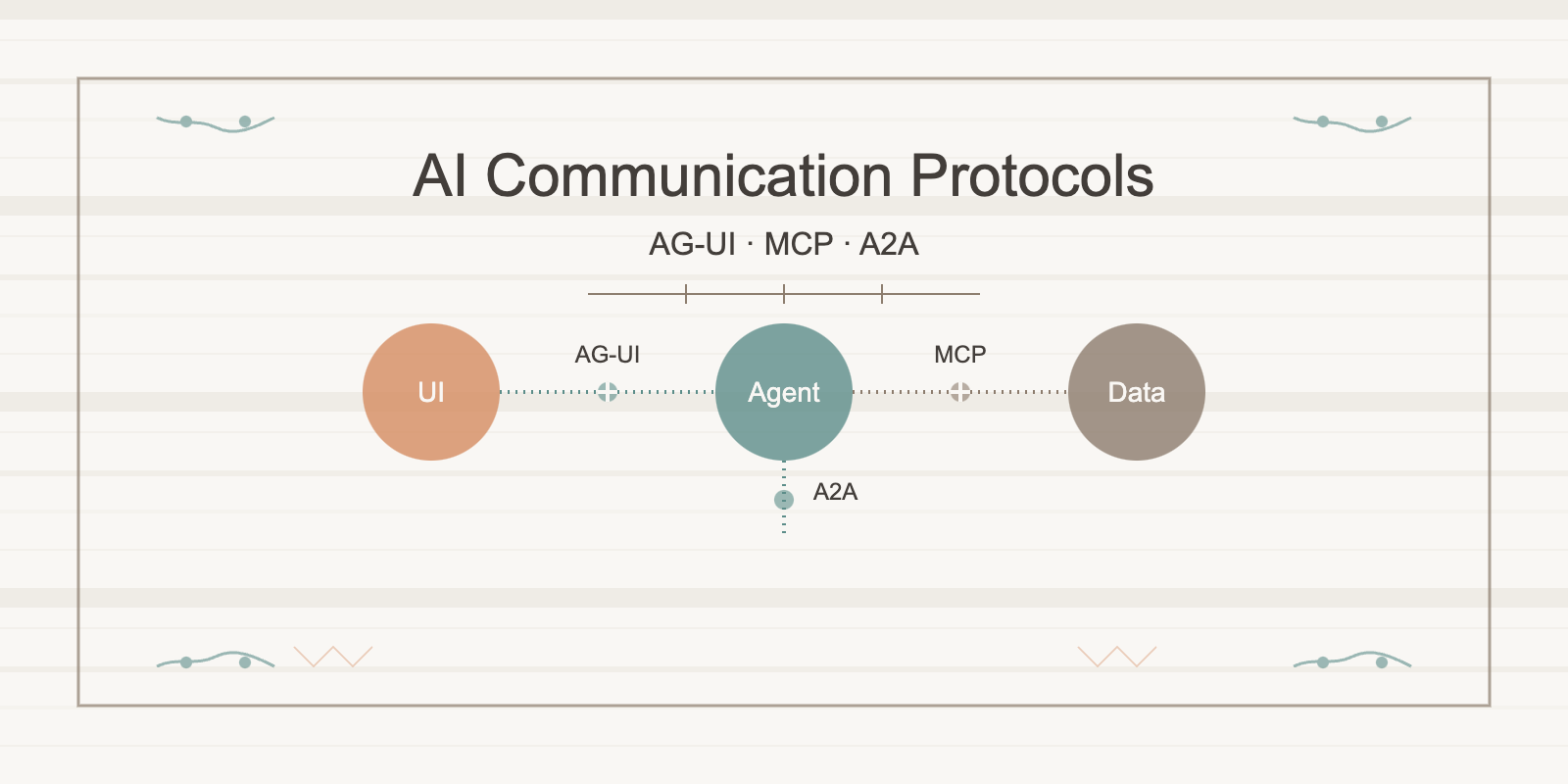
Introduction
- As AI agent technology rapidly develops, standardizing communication protocols for different scenarios has become a key industry requirement. This report aims to analyze the characteristics of the AG-UI protocol and its relationship with MCP and A2A protocols.
- AG-UI, as an emerging open-source protocol, focuses on solving communication problems between AI agents and frontend applications, forming a complementary relationship with existing MCP (Model Context Protocol) and A2A (Agent2Agent) protocols, collectively building a complete AI agent communication ecosystem.
Part 1: AG-UI Protocol Overview
-
Definition and Objectives: AG-UI (Agent-User Interaction Protocol) is an open, lightweight, event-based protocol designed to standardize communication between AI agents and frontend applications. As stated in the official documentation, AG-UI "standardizes how front-end applications connect to AI agents through an open protocol," serving as a "universal translator for AI-driven systems."
-
Core Technical Features:
- Real-time interactivity: Supports real-time event streaming, ensuring synchronization between users and agents for a smooth interaction experience
- Human-in-the-loop collaboration: Allows users to intervene in AI decision processes, suitable for complex workflows requiring human confirmation or guidance
- Transport agnosticism: Supports various transport methods such as SSE, WebSockets, and webhooks, adapting to different application scenarios
- Lightweight design: Minimizes dependencies, facilitates integration, suitable for projects of all scales from simple demonstrations to enterprise-level applications
- Standardized events: Defines 16 event types (such as TEXT_MESSAGE_CONTENT, TOOL_CALL_START), simplifying development
-
Working Mechanism: AG-UI implements agent-frontend communication through an event-driven architecture. As described in the Reddit discussion: "The magic happens in 5 simple steps: 1. Your app sends a request to the agent; 2. Then opens a single event stream connection; 3. The agent sends lightweight event packets as it works; 4. Each event flows to the Frontend in real-time; 5. Your app updates instantly with each new development."
Part 2: Comparison of AG-UI with MCP and A2A
-
Functional Positioning:
- MCP (Model Context Protocol): Focuses on connecting AI agents with external data sources and tools (such as GitHub, Notion, etc.)
- A2A (Agent2Agent Protocol): Enables communication and collaboration between different AI agents
- AG-UI: Connects backend AI agents with frontend user interfaces, enabling real-time interaction
-
Technical Implementation:
- MCP: Utilizes a client-server architecture, providing pre-built integrations, simplifying interactions between AI models and external systems
- A2A: Implemented through JSON-RPC 2.0 over HTTP(S), supporting task delegation, information exchange, and secure collaboration
- AG-UI: Implements real-time communication based on event streams (such as SSE, WebSocket), defining 16 standard event types
-
Application Scenarios:
- MCP: Suitable for scenarios requiring access to external data and tools, such as data retrieval, API calls, etc.
- A2A: Suitable for scenarios where multiple agents need to collaborate on complex tasks, such as task allocation, information sharing, etc.
- AG-UI: Suitable for scenarios requiring real-time user interaction, such as chat interfaces, collaborative editing, etc.
Part 3: Collaborative Relationship Between the Three Protocols
-
Complementary Collaboration: These three protocols are not in competition but form a complementary ecosystem. As stated in the "Zhizhiliu" WeChat article: "AG-UI's development is iterative, first with MCP solving structured communication of modular components, then A2A implementing orchestration between specialized Agents, and AG-UI being the first to clearly connect backend Agents with frontend user interfaces."
-
Complete Communication Chain: The three protocols collectively build a complete AI agent communication chain:
- MCP handles communication between agents and external tools/data
- A2A handles communication between agents
- AG-UI handles communication between agents and user interfaces
-
Practical Application Scenarios: In a customer support scenario, an agent might access customer history through MCP, collaborate with technical support agents through A2A to solve problems, and finally update users in real-time through AG-UI in a chat interface. As @akshay_pachaar emphasized on the X platform, AG-UI "completes the protocol stack."
Part 4: AG-UI Ecosystem and Integration
-
Framework Integration: AG-UI has achieved "out-of-the-box" integration with multiple mainstream AI frameworks, including LangChain, Mastra, CrewAI, and AG2, with more partnerships coming in the future.
-
Developer Tools: AG-UI provides TypeScript and Python SDKs, simplifying the integration process. Developers can quickly build React frontends using CopilotKit components or explore interactive playgrounds through quick start guides.
-
Community Development: AG-UI has established working groups that meet regularly to drive the development and improvement of the protocol. As mentioned in the Hacker News discussion: "We have the first working group this Friday, to help expand and steer the direction of the protocol."
Conclusion
- AG-UI, as an emerging open-source protocol, fills the communication gap between AI agents and frontend applications, forming a complementary relationship with MCP and A2A to collectively build a complete AI agent communication ecosystem.
- The three protocols each have their focus: MCP connects agents with external tools/data, A2A enables inter-agent collaboration, and AG-UI connects agents with user interfaces.
- As AI agent technology continues to evolve, the collaboration of these three protocols will provide developers with a more flexible and efficient AI application development environment, promoting the widespread application of AI agent technology across various industries.
- Developers can quickly get started with AG-UI through official documentation, GitHub repositories, demo applications, and community support resources to build real-time, interactive AI applications.
Related Articles
- Understanding A2A Protocol: A Comprehensive Guide
- A2A Protocol Development Guide(TypeScript)
- A2A vs MCP: The Protocol Revolution in AI Architecture
Goto A2A